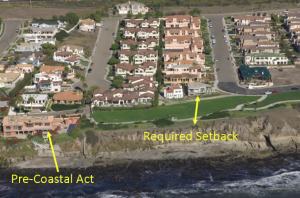2015 is shaping up as a year of significant developments in land use law thanks to the Governor, the Legislature, and the courts. Here’s an update on anticipated developments related to Sea Level Rise, Affordable Housing, Traffic Impact Analysis and the Drought, any or all of which could constrain land development:
. . . SEA LEVEL RISE AND THE COASTAL COMMISSION: Prospective purchasers, developers, and owners of coastal land should pay close attention to the Coastal Commission’s development of policies to address rising sea level and its implication not just for coastal resources, but also for existing and proposed development. Although final guidance has not yet been issued, the Commission’s Draft Sea-Level Rise Policy Guidance concludes that sea level rise threatens “seven wastewater treatment plants, commercial fishery facilities, marine terminals, Coastal Highway One, fourteen power plants, residential homes, and other important develop ment and infrastructure.” Add in impacts to tourism, commercial fisheries, coastal agriculture, the ports, and sensitive coastal resources and it is easy to anticipate that the projected risks from sea level rise will create tough decisions for the Commission as it acts on Local Coastal Programs, LCP amendments, and Coastal Development Permits. Hazard avoidance and mitigation are likely to result in proposals for significant constraints on development. Every site and project will be different, but it will be important to evaluate the potential significance of sea level rise over the life of the project in the context of any investment or development within the Coastal Zone. The picture above is from a presentation by Charles Lester, Executive Director of the Coastal Commission, to the Senate Budget Subcommittee 2 on March 20, 2014. It shows a pre-Coastal Act home and more current setback requirements along a blufftop in Pismo Beach which has been impacted by bluff erosion.
ment and infrastructure.” Add in impacts to tourism, commercial fisheries, coastal agriculture, the ports, and sensitive coastal resources and it is easy to anticipate that the projected risks from sea level rise will create tough decisions for the Commission as it acts on Local Coastal Programs, LCP amendments, and Coastal Development Permits. Hazard avoidance and mitigation are likely to result in proposals for significant constraints on development. Every site and project will be different, but it will be important to evaluate the potential significance of sea level rise over the life of the project in the context of any investment or development within the Coastal Zone. The picture above is from a presentation by Charles Lester, Executive Director of the Coastal Commission, to the Senate Budget Subcommittee 2 on March 20, 2014. It shows a pre-Coastal Act home and more current setback requirements along a blufftop in Pismo Beach which has been impacted by bluff erosion.
. . . AFFORDABLE HOUSING FEES: We told you earlier this year that the California Supreme Court will be weighing in on the validity of an in lieu affordable housing fee in San Jose. Oral arguments in California Building Industry Association v. City of San Jose (click here to read the appellate court decision which is under review) were heard on April 8. CCN’s Mike Zischke was in attendance and observed an engaged and inquisitive Court. When this decision comes down, its significance likely will go beyond the affordable housing issue. With two new Justices sworn in at the beginning of this year, this decision could foretell where the Court will lean on land use issues, particularly those involving exactions and impact fees.
of an in lieu affordable housing fee in San Jose. Oral arguments in California Building Industry Association v. City of San Jose (click here to read the appellate court decision which is under review) were heard on April 8. CCN’s Mike Zischke was in attendance and observed an engaged and inquisitive Court. When this decision comes down, its significance likely will go beyond the affordable housing issue. With two new Justices sworn in at the beginning of this year, this decision could foretell where the Court will lean on land use issues, particularly those involving exactions and impact fees.
. . . THE DROUGHT: Governor Brown’s Executive Order calling for a 25% reduction in the State’s water usage will impact not only daily life for Californians (there goes that ten-minute shower), but potentially development proposals. At a time when some areas in the state are experiencing housing shortages, there undoubtedly will be pressure from some interest groups to cut back on the development of new housing. It’s too early yet to understand what the full effect of Executive Order B-29-15 will be, as local water agencies and local governments will be developing their own policies to comply with the Governor’s directive.
 Lay of the Land
Lay of the Land

